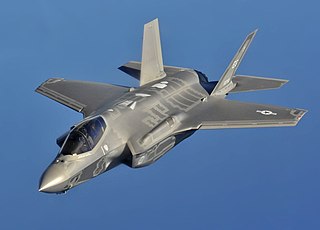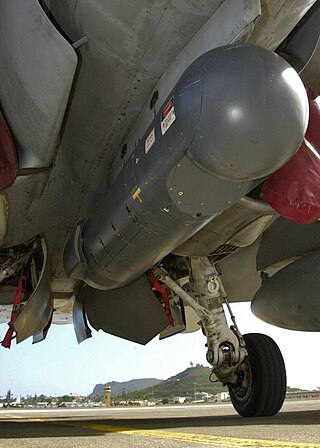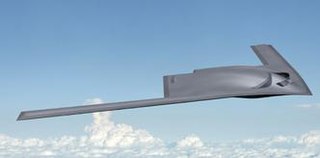Related Research Articles
The AIM-120 Advanced Medium-Range Air-to-Air Missile(AMRAAM) (pronounced AM-ram /æmɹæm/), is an American beyond-visual-range air-to-air missile capable of all-weather day-and-night operations. It uses active transmit-receive radar guidance instead of semi-active receive-only radar guidance. It is a fire-and-forget weapon, unlike the previous generation Sparrow missiles which required full guidance from the firing aircraft. When an AMRAAM missile is launched, NATO pilots use the brevity code "Fox Three".

The AGM-88 HARM is a tactical, air-to-surface anti-radiation missile designed to home in on electronic transmissions coming from surface-to-air radar systems. It was originally developed by Texas Instruments as a replacement for the AGM-45 Shrike and AGM-78 Standard ARM system. Production was later taken over by Raytheon Corporation when it purchased the defense production business of Texas Instruments.

The Northrop Grumman B-2 Spirit, also known as the Stealth Bomber, is an American heavy strategic bomber, featuring low-observable stealth technology designed to penetrate dense anti-aircraft defenses. A subsonic flying wing with a crew of two, the plane was designed by Northrop and produced from 1987 to 2000. The bomber can drop conventional and thermonuclear weapons, such as up to eighty 500-pound class (230 kg) Mk 82 JDAM GPS-guided bombs, or sixteen 2,400-pound (1,100 kg) B83 nuclear bombs. The B-2 is the only acknowledged in-service aircraft that can carry large air-to-surface standoff weapons in a stealth configuration.

The Lockheed Martin F-35 Lightning II is an American family of single-seat, single-engine, all-weather stealth multirole combat aircraft that is intended to perform both air superiority and strike missions. It is also able to provide electronic warfare and intelligence, surveillance, and reconnaissance capabilities. Lockheed Martin is the prime F-35 contractor, with principal partners Northrop Grumman and BAE Systems. The aircraft has three main variants: the conventional takeoff and landing (CTOL) F-35A, the short take-off and vertical-landing (STOVL) F-35B, and the carrier-based (CV/CATOBAR) F-35C.

Northrop Grumman Corporation is an American multinational aerospace and defense technology company. With 95,000 employees and an annual revenue in excess of $30 billion, it is one of the world's largest weapons manufacturers and military technology providers. The firm ranks No. 101 on the 2022 Fortune 500 list of America's largest corporations.

The Northrop/McDonnell Douglas YF-23 is an American single-seat, twin-engine, supersonic stealth fighter aircraft technology demonstrator designed for the United States Air Force (USAF). The design was a finalist in the USAF's Advanced Tactical Fighter (ATF) competition, battling the Lockheed YF-22 for a production contract. Two YF-23 prototypes were built.

Suppression of Enemy Air Defenses (SEAD, pronounced ), also known in the United States as "Wild Weasel" and (initially) "Iron Hand" operations, are military actions to suppress enemy surface-based air defenses, including not only surface-to-air missiles (SAMs) and anti-aircraft artillery (AAA) but also interrelated systems such as early-warning radar and command, control and communication (C3) functions, while also marking other targets to be destroyed by an air strike. Suppression can be accomplished both by physically destroying the systems or by disrupting and deceiving them through electronic warfare. In modern warfare, SEAD missions can constitute as much as 30% of all sorties launched in the first week of combat and continue at a reduced rate through the rest of a campaign. One quarter of American combat sorties in recent conflicts have been SEAD missions. Despite generally being associated with aircraft, SEAD missions may be performed using any means, including through actions by ground forces.

The AN/AAQ-28(V) Litening targeting pod is an advanced precision targeting pod system currently operational with a wide variety of aircraft worldwide. The research and development of the Litening was first undertaken by Rafael Advanced Defense Systems' Missiles Division in Israel, with subsequent completion of Litening I for use in the Israeli Air Force.

The AGM-86 ALCM is an American subsonic air-launched cruise missile (ALCM) built by Boeing and operated by the United States Air Force. This missile was developed to increase the effectiveness and survivability of the Boeing B-52H Stratofortress strategic bomber. The missile dilutes an enemy's forces and complicates air defense of its territory.

The ADM-160 MALD is an air-launched, expendable decoy missile developed by the United States. It uses gradient-index optics to create a radar cross section that simulates allies' airplane, in order to stimulate, confuse, and degrade the capability of missile defense systems. Later variants (MALD-J) are additionally equipped with electronic countermeasures to actively jam early warning and target acquisition radars.

The AGM-158 JASSM is a low detection standoff air-launched cruise missile developed by Lockheed Martin for the United States Armed Forces. It is a large, stealthy long-range weapon with a 1,000-pound (450 kg) armor piercing warhead. It completed testing and entered service with the U.S. Air Force in 2009, and has entered foreign service in Australia, Finland, and Poland as of 2014. An extended range version of the missile, the AGM-158B JASSM-ER, entered service in 2014 as well as an anti-ship derivative, the AGM-158C LRASM, in 2018. By September 2016, Lockheed Martin had delivered 2,000 total JASSMs comprising both variants to the USAF.

The Next-Generation Bomber was a program to develop a new medium bomber for the United States Air Force. The NGB was initially projected to enter service around 2018 as a stealthy, subsonic, medium-range, medium payload bomber to supplement and possibly—to a limited degree—replace the U.S. Air Force's aging bomber fleet. The Long Range Strike Bomber (LRS-B) heavy bomber program superseded the NGB program.

The Long Range Strike Bomber (LRS-B) is a development and acquisition program to develop a long-range strategic bomber for the United States Air Force, intended to be a heavy-payload stealth aircraft capable of delivering thermonuclear weapons. Initial capability is planned for the mid-2020s. A request for proposal to develop the aircraft was issued in July 2014. The Air Force plans to procure at least 100 of the LRS-B aircraft at a cost of an estimated $550 million each, with potentially as many as 200 units being considered to enter service eventually. A development contract was awarded to Northrop Grumman for its B-21 Raider in October 2015. Due to the sensitive nature much about the project is highly classified and little information is available to the public. As of late 2019, it was known that construction of the aircraft had commenced, and on December 2, 2022, it was unveiled to the public.
The Northrop Grumman RQ-180 is an American stealth unmanned aerial vehicle (UAV) surveillance aircraft intended for contested airspace. As of 2019, there had been no images or statements released, but growing evidence points to the existence of the RQ-180 and its use in regular front-line service. The use of the nickname "White Bat" in a 2021 video released by the US Air Force Profession of Arms Center of Excellence (PACE) suggests that the military may be preparing to release information on the RQ-180.

The Northrop Grumman B-21 Raider is an American strategic bomber under development for the United States Air Force (USAF) by Northrop Grumman. As part of the Long Range Strike Bomber (LRS-B) program, it is to be a long-range, stealth intercontinental strategic bomber for the USAF, able to deliver conventional and thermonuclear weapons. The Air Force intends the B-21 to replace the Rockwell B-1 Lancer and Northrop Grumman B-2 Spirit by 2040, and possibly the Boeing B-52 Stratofortress after that.

The LGM-35 Sentinel, also known as the Ground Based Strategic Deterrent (GBSD), is a future American land-based intercontinental ballistic missile system (ICBM) currently in the early stages of development. It is slated to replace Minuteman III missiles, currently stationed in North Dakota, Wyoming, Montana, and Nebraska from 2029 through 2075. In 2020 the Department of the Air Force awarded defense contractor Northrop Grumman a $13.3 billion sole-source contract for development of the LGM-35 after Boeing withdrew its proposal. Northrop Grumman's subcontractors on the LGM-35 include Lockheed Martin, General Dynamics, Bechtel, Honeywell, Aerojet Rocketdyne, Parsons, Textron, and others.

The AGM-183 ARRW was a hypersonic air-to-ground missile planned for use by the United States Air Force. Developed by Lockheed Martin, the boost-glide vehicle is propelled to a maximum speed of more than Mach 5 by a rocket motor before gliding toward its target. The program was cancelled in March 2023 after multiple failed tests. The program, however, continued despite the cancellation and was announced to still be in development following additional, undisclosed testing.
The Next Generation Air Dominance (NGAD) is a United States Air Force (USAF) sixth-generation air superiority initiative with a goal of fielding a "family of systems" that is to succeed the Lockheed Martin F-22 Raptor. A crewed fighter aircraft is the centerpiece program of NGAD and has been referred to as the Penetrating Counter-Air (PCA) and is to be supported by uncrewed collaborative combat aircraft (CCA), or loyal wingman platforms, through manned-unmanned teaming (MUM-T).
SCIFIRE or the Southern Cross Integrated Flight Research Experiment is an American-Australian military technology partnership that is developing a solid-rocket boosted, air-breathing, hypersonic conventional cruise missile that can be launched by existing fighter or bomber aircraft.
The Hypersonic Attack Cruise Missile (HACM) is a scramjet-powered hypersonic air-launched cruise missile project, the successor of the Hypersonic Air-breathing Weapon Concept (HAWC) and the SCIFiRE hypersonic programs.
References
- ↑ Stephen Losey (9 June 2022). "US Air Force awards contracts to start designing F-35 weapon". Defense News . Retrieved 20 August 2023.
- ↑ John Tirpak (15 June 2022). "New SiAW Seen as Modular, Pathfinder Weapon". Air & Space Forces Magazine. Retrieved 20 August 2023.
- ↑ Stephen Losey (26 September 2023). "Northrop wins $705 million contract for F-35 air-to-ground weapon". Defense News. Retrieved 13 November 2023.
- ↑ Zach Rosenberg (28 September 2023). "Northrop Grumman awarded US Air Force contract to build Stand-in Attack Weapon". Janes. Retrieved 13 November 2023.